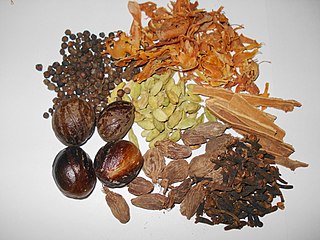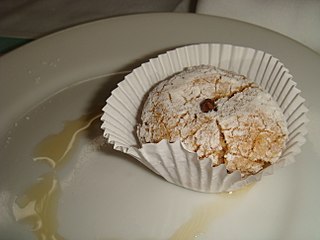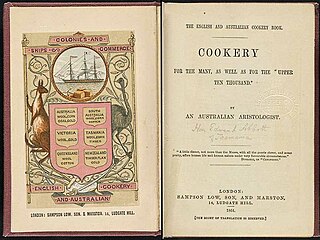
In the culinary arts, a spice is any seed, fruit, root, bark, or other plant substance in a form primarily used for flavoring or coloring food. Spices are distinguished from herbs, which are the leaves, flowers, or stems of plants used for flavoring or as a garnish. Spices are sometimes used in medicine, religious rituals, cosmetics, or perfume production. They are usually classified into spices, spice seeds, and herbal categories.For example, vanilla is commonly used as an ingredient in fragrance manufacturing. Plant-based sweeteners such as sugar are not considered spices.

An apple pie is a fruit pie in which the principal filling is apples. Apple pie is often served with whipped cream, ice cream, custard or cheddar cheese. It is generally double-crusted, with pastry both above and below the filling; the upper crust may be solid or latticed. The bottom crust may be baked separately ("blind") to prevent it from getting soggy. Deep-dish apple pie often has a top crust only. Tarte Tatin is baked with the crust on top, but served with it on the bottom.

Garam masala is a blend of ground spices originating from the Indian subcontinent. It is common in Indian, Pakistani, Nepalese, Bangladeshi, Sri Lankan and Caribbean cuisines. It is used alone or with other seasonings. The specific fixings differ by district, but it regularly incorporates a blend of flavors like cardamom, cinnamon, cumin, cloves and peppercorns. Garam masala can be found in a wide range of dishes, including marinades, pickles, stews, and curries.

The Forme of Cury is an extensive 14th-century collection of medieval English recipes. Although the original manuscript is lost, the text appears in nine manuscripts, the most famous in the form of a scroll with a headnote citing it as the work of "the chief Master Cooks of King Richard II". The name The Forme of Cury is generally used for the family of recipes rather than any single manuscript text. It is among the oldest extant English cookery books, and the earliest known to mention olive oil, gourds, and spices such as mace and cloves.

Gingerbread refers to a broad category of baked goods, typically flavored with ginger, cloves, nutmeg, and cinnamon and sweetened with honey, sugar, or molasses. Gingerbread foods vary, ranging from a moist loaf cake to forms nearly as crisp as a ginger snap.

Spice mixes are blended spices or herbs. When a certain combination of herbs or spices is called for in a recipe, it is convenient to blend these ingredients beforehand. Blends such as chili powder, curry powder, herbes de Provence, garlic salt, and other seasoned salts are traditionally sold pre-made by grocers, and sometimes baking blends such as pumpkin pie spice are also available. These spice mixes are also easily made by the home cook for later use.

Mincemeat is a mixture of chopped dried fruit, distilled spirits and spices, and often beef suet, usually used as a pie or pastry filling. Mincemeat formerly contained meat, notably beef or venison. Many modern recipes replace the suet with vegetable shortening.

Quatre épices is a spice mix used mainly in French cuisine, but can also be found in some Middle Eastern kitchens. Its name is French for "four spices"; it is considered the French allspice. The spice mix contains ground pepper, cloves, nutmeg and dried ginger. Some variations of the mix use allspice or cinnamon instead of pepper, or cinnamon instead of ginger.

Ras el hanout or rass el hanout is a spice mix found in varying forms in Tunisia, Algeria, and Morocco. The name means "head of the shop" in Arabic and implies a mixture of the best spices the seller has to offer. Ras el hanout is used in many savoury dishes, sometimes rubbed on meat or fish, or stirred into couscous, pasta or rice.

Carrot cake is cake that contains carrots mixed into the batter.

Mixed spice, also called pudding spice, is a British blend of sweet spices, similar to the pumpkin pie spice used in the United States. Cinnamon is the dominant flavour, with nutmeg and allspice. It is often used in baking, or to complement fruits or other sweet foods.

The English and Australian Cookery Book is considered to be the first Australian cookbook. Published in London in 1864, the full title of the first edition reads: The English and Australian Cookery Book: Cookery for the Many, as well as the Upper Ten Thousand - by an Australian Aristologist. The author, who listed himself only by the initials "E.A." in the introduction, was a Tasmanian named Edward Abbott.
Bahārāt is a spice mixture or blend used in Middle Eastern cuisines. The mixture of finely ground spices is often used to season lamb and mutton, fish, chicken, beef, and soups, and may also be used as a condiment.

Pumpkin pie is a dessert pie with a spiced, pumpkin-based custard filling. The pumpkin and pumpkin pie are both a symbol of harvest time, and pumpkin pie is generally eaten during the fall and early winter. In the United States and Canada it is usually prepared for Thanksgiving, Christmas, and other occasions when pumpkin is in season.

Mizrahi Jewish cuisine is an assortment of cooking traditions that developed among the Jews of the Middle East, North Africa, Asia, and Arab countries. Mizrahi Jews have also been known as Oriental Jews.
Powder-douce is a spice mix used in Medieval and Renaissance cookery. Like modern spice mixes such as Italian seasoning or garam masala, there was not a set ingredient list, and it varied from cook to cook. The author of the 14th-century manuscript Le Ménagier de Paris suggested a mix of grains of paradise, ginger, cinnamon, nutmeg, sugar, and galangal.

Smoking Bishop is a type of mulled wine, punch, or wassail, especially popular in Victorian England at Christmas time, and it is mentioned in Dickens' 1843 story A Christmas Carol.

The Good Huswifes Jewell is an English cookery book by the cookery and housekeeping writer Thomas Dawson, first published in 1585. It includes recipes for medicines as well as food. To the spices found in Medieval English cooking, the book adds herbs, especially parsley and thyme. Sugar is used in many of the dishes, along with ingredients that are uncommon in modern cooking like violets and rosewater.
Powder-forte was a medieval spice mix similar to poudre douce, but often incorporating more pungent flavors like pepper. Spice mixes like powder-forte were a common ingredient in the recorded recipes of medieval cuisine, often used in combination with foods that are not heavily spiced in modern preparations. One example is a recipe for cherries, washed clean with wine and filtered through a cloth, then heated with "white grease" and rice flour in a pot until stiff. To this cherry mixture, the cook would add honey, vinegar, egg yolk and "strong powder" - in this case, a mix of cinnamon and cypress root. Along with poudre douce, poudre fine and poudre lombard it is one of four medieval spice mixtures found throughout an assortment of medieval cookery manuscripts.
Pie in American cuisine has roots in English cuisine and has evolved over centuries to adapt to American cultural tastes and ingredients. The creation of flaky pie crust shortened with lard is credited to American innovation.
















